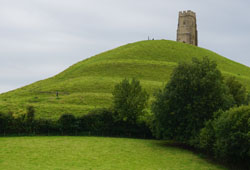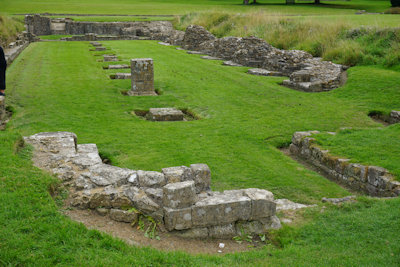
The small town of Glastonbury, located in the county of Somerset in western England, is a magical place filled with legends and wonder. It is said that Joseph of Arimathea, a disciple of Jesus who donated his tomb to the “Son of God” and caught his blood from the cross in the cup used at the Last Supper, visited the region a mere three decades after the events of the Bible, bringing with him one of the most sought after relics in all of history – the Holy Grail.
The Glastonbury Tor, meanwhile – a steep hill that dominates the local landscape – is thought to be the Isle of Avalon from the time of King Arthur, while both Arthur and his Queen Guinevere are believed to be buried at the old Glastonbury Abbey. The Abbey itself was demolished under orders from King Henry VIII in 1539, although the remnants of what was once the second largest Abbey in England can still be seen to this day.
No matter how widespread legends may become, sometimes they are just that – nothing more than legends. Historians, on the other hand, only deal with facts, and are quick to point out that the historical records of Glastonbury do not support the myths of the region. Despite such arguments, the legends are still believed by many, and thousands upon thousands of men, women, and children make the pilgrimage to Glastonbury every year to see the wonders of the region firsthand.
Although the Glastonbury Tor and Chalice Well are key components of those legends, the Glastonbury Abbey still serves as the centerpiece for both Joseph of Arimathea and King Arthur. The history of the Abbey is incomplete, however, as it was built during the “Dark Ages” following the Roman evacuation of Britain, a time when accurate historical records are practically non-existence. It is not until the twelfth century and the writings of William of Malmesbury that any sort of account of the Abbey has survived. In comparison, land charters mark the believed construction date of the Abbey to be in the late seventh century.
The original Glastonbury Abbey was made of wood, and while any remnants would have decayed a long time ago, legend has it that another church sat on the same site over 600 years earlier. A tenth century document entitled The Life of Dunstan, for instance, claims that “in that place at God’s command the first neophytes of the catholic law discovered an ancient church, built by no human skill, consecrated to Christ and the holy Mary.”
The tale was later incorporated into William of Malmesbury’s Concerning the Early History of the Church of Glastonbury. “In later medieval interpolations to William’s account, twelve disciples were sent from Gaul, with Joseph at their head,” Philip Rahtz and Lorna Watts explain in their 2003 book Glastonbury: Myths & Archaeology. “They built a wattle church in honor of the Blessed Mary, 31 years after the passion and 15 years after the Assumption (i.e., in AD 63). This was the first church in the land, and it was dedicated to his mother by the Lord himself. The place was then left deserted until the days of King Lucius and the missionaries sent from Rome.”
By the year 1345, the legend of Joseph of Arimathea had been fully incorporated into the factual history of the Glastonbury Abbey, and it was even believed that Joseph himself was buried on the grounds. Although the exact location has never been found, the supposed tomb of King Arthur and Queen Guinevere was unearthed at Glastonbury Abbey in the year 1191. King Henry II had acquired “secret information from an ancient Welsh bard” about the location of Arthur’s final resting place and told the monks of the Abbey where to dig.
The exhumation was witnessed by a third-party not associated with either the King or the Abbey. “Now the body of King Arthur was found in our own days at Glastonbury, deep down in the earth and encoffined in a hollow oak between two stone pyramids,” Gerald of Wales later wrote. “In the grave was a cross of lead, placed under a stone and not above it. I have felt the letters engraved thereon – ‘Here lies buried the renowned King Arthur, with Guinevere his second wife, in the isle of Avalon.’ Two parts of the tomb were allotted to the bones of the man, while the remaining third contained the bones of the woman, and there was found a yellow tress of woman’s hair still retaining its color and freshness. But when a certain monk snatched it and lifted it with greedy hand, it straightaway fell into dust.”
Both the remains of Arthur and Guinevere, as well as the cross that marked the tomb, were quickly transferred into the Abbey itself. During the sixteenth century, King Henry VIII established the Church of England and in affect “outlawed” the Roman Catholic Church. This led to the eradication of Catholic institutes, and the Glastonbury Abbey was destroyed in the year 1539 as part of the Dissolution. It is unknown what became of the remnants of Arthur’s tomb afterwards.
While the legend of King Arthur is universal, most historians believe Arthur to be nothing more than a myth. The supposed reign of the King of Camelot was during the sixth century, but there is no correlating historical evidence that such a man ever lived. Although a few brief mentions have survived from the time period, it wasn’t until Geoffrey of Monmouth’s History of the Kings of Britain in the mid-twelfth century that any sort of biographical information first appeared. Despite named a “history,” however, Geoffrey was more of a storyteller and little historical value is now placed on his writings.
Although the existence of King Arthur is doubtful in the minds of many contemporary historians, it is more readily agreed that his grave was indeed unearthed in 1191 – only that the discovery was a hoax. While the etchings of the cross found in the tomb did predate the time of exhumation, for instance, the style was not consistent with the sixth century in which Arthur would have lived and died.
More significantly, a fire in 1184 destroyed the Glastonbury Abbey, and the monks were in need of monetary funds to rebuild the structure. “The years 1184-1192 were a crisis period for the Abbey,” Philip Rahtz and Lorna Watts explain in Glastonbury: Myths & Archaeology. “Drastic measures were required to increase resources after the fire, to attract pilgrims from far and wide. The monks would have hoped to emulate the remarkable success of Canterbury in establishing the cult of St. Thomas a Becket, murdered in 1170 – the monks there also badly needed money to rebuild after the Canterbury fire of 1174. Attractions included phials said to hold diluted blood of St. Thomas, which were on sale to pilgrims. The establishment of an Arthurian cult would, it was hoped, secure such aims for Glastonbury.”
The same could be said regarding the legends surrounding Joseph of Arimathea. In the case of Joseph, however, the myth extends to the nearby Chalice Well, where Joseph either washed the Holy Grail in water or buried it under the base of the well, depending on the story. The Chalice Well is now a spiritual sanctuary, and the water itself is said to contain healing powers. The rocks that the water flows over are stained red, ostensibly from the blood of Christ that was contained within the cup. In reality, the water is heavy with iron, which is more likely responsible for the red-tinge of the rocks.
The Chalice Well sits at the base of the Glastonbury Tor, a giant hill that dominates the local landscape. In earlier times, the land surrounding the Tor was a marsh and when flooded, gave the appearance of an island rather than an extension of the English countryside. The legend of King Arthurs states that he was taken to the Isle of Avalon upon being mortally wounded at the Battle of Camlann. It was at Avalon that the sword Excalibur was forged, and into the same waters that the sword was later returned.
According to the myths of Glastonbury, the Tor is the Isle of Avalon from legend, giving further credence to King Arthur’s burial at the Glastonbury Abbey.
The small town of Glastonbury is indeed a magical place. Fact has become intertwined with fiction over the centuries, however, making the history of the Glastonbury Abbey, Chalice Well, and Glastonbury Tor inseparable from the legends of King Arthur and Joseph of Arimathea. The legends themselves may or may not be true, but are still worthy of being explored – as well as remembered – nonetheless.
Anthony Letizia





